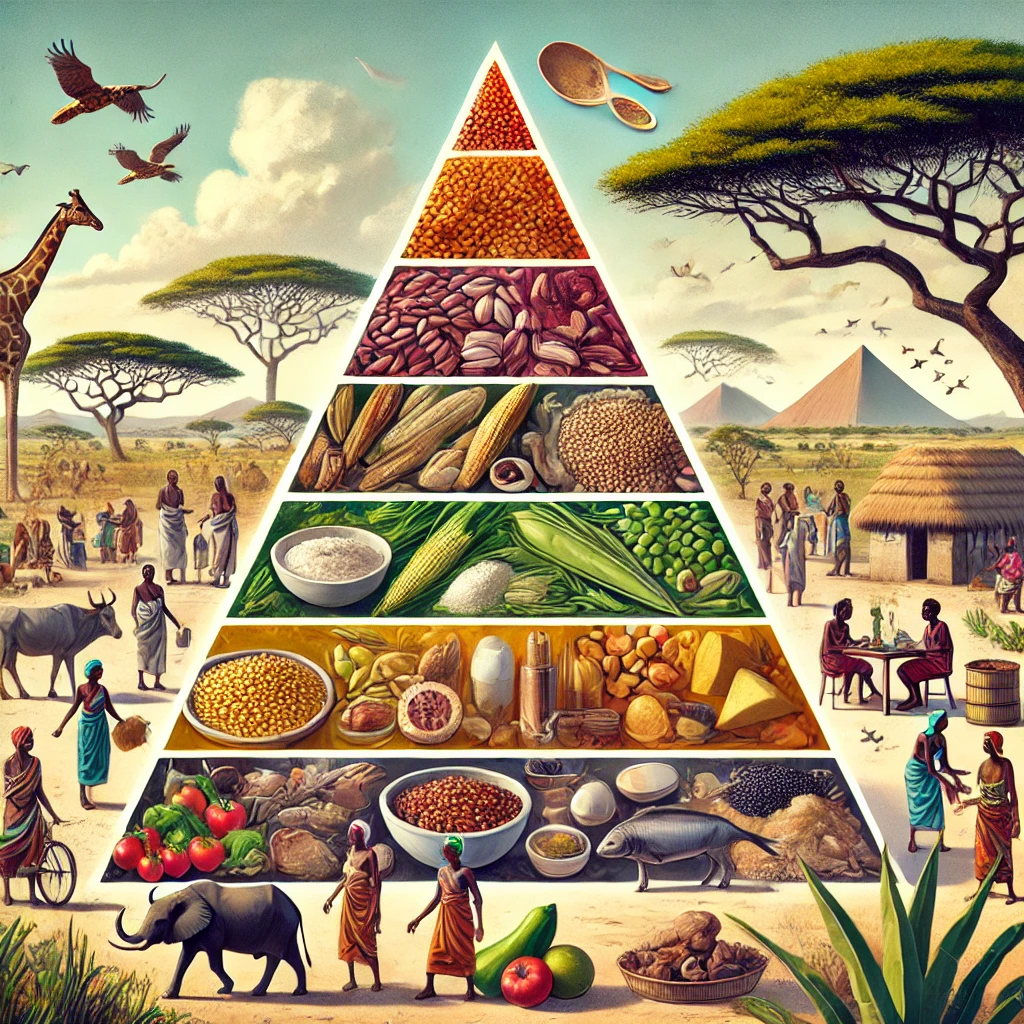Introduction: Understanding Food Energy Pyramid Africa
The Food Energy Pyramid Africa is a conceptual model that represents the distribution of different food groups and their contributions to nutritional needs. In Africa, this model takes on unique characteristics due to diverse climates, cultures, and socio-economic conditions. This article delves into the African food energy pyramid, examining the roles of various food groups, the impact of regional variations, and the challenges and strategies relevant to achieving food security on the continent.
Various Food Groups and Their Importance in Africa
Starchy Staples: The Foundation of Nutrition
In Africa, starchy staples such as maize, rice, cassava, and sorghum form the base of the food energy pyramid. These carbohydrates are crucial for energy, providing fuel for daily activities and vital functions. They are often consumed in large quantities due to their affordability and accessibility.
Legumes and Nuts: Protein-Packed Powerhouses
Legumes like beans, lentils, and chickpeas, along with various nuts, are essential sources of protein in the African diet. They contribute to muscle repair and growth, playing a critical role in the diet of those who have limited access to animal products.
Fruits and Vegetables: Vitamins and Minerals Galore
This group includes a variety of fruits and vegetables abundant in Africa, which are vital for their vitamins, minerals, and fibers. These nutrients support bodily functions such as digestion, immune response, and skin health.
Animal Products: Concentrated Nutrients
Although less commonly consumed due to higher costs, animal products like meat, fish, dairy, and eggs provide concentrated sources of protein, fats, and micronutrients crucial for brain development and bone health.
Cultural and Regional Variations in Africa’s Food Pyramid
Geographic Factors: Shaping the Pyramid
The diversity of Africa’s geography, from vast savannahs to dense rainforests, influences the availability of different food groups. For example, coastal regions have better access to fish, while inland areas may rely more on livestock and crop farming.
Cultural Factors: Dietary Diversity
Cultural preferences and traditions also dictate the composition of local diets. For instance, Ethiopian cuisine heavily features teff, used in injera, while West African countries favor yam and cassava.
Challenges to Food Security: Tackling the Issues at the Root
Political Instability: A Barrier to Consistent Supply
Political unrest can disrupt food production and distribution, posing significant challenges to food security. Ensuring stable governance is crucial for maintaining the supply chain integrity.
Strategies for Improvement: Collaborative Efforts in Food Energy Pyramid Africa
The Key Role of Governments
Governments in Africa are pivotal in shaping the landscape of food security and nutrition. To enhance the effectiveness of the food energy pyramid, governments can adopt several strategic approaches:
- Policy Development: Creating and enforcing policies that encourage sustainable agricultural practices and protect the rights of smallholder farmers is essential. This includes land use policies, subsidies for eco-friendly farming techniques, and import-export regulations that favor local produce.
- Infrastructure Investment: Building and maintaining infrastructure such as roads, storage facilities, and irrigation systems can significantly reduce food loss post-harvest and ensure that produce reaches markets in optimal condition.
- Education and Public Health Programs: Governments can organize campaigns to educate the public about nutritious diets and the importance of diversity in food consumption. Additionally, implementing school feeding programs can ensure children receive at least one balanced meal per day, which can be pivotal for their overall health and education.
- Fiscal Incentives: Offering tax breaks, grants, or financial assistance to agribusinesses that adhere to sustainable practices can encourage more widespread adoption of such methods.
The Key Role of Organizations
Non-governmental organizations (NGOs), international aid agencies, and community-based organizations are also crucial in improving food security in Africa through the following measures:
- Direct Aid and Relief: In times of crisis, such as drought or conflict, organizations can mobilize quickly to provide necessary food aid and relief to affected populations, ensuring basic nutritional needs are met.
- Sustainable Development Projects: Many organizations focus on sustainable development, which includes teaching sustainable agricultural techniques, providing seeds for more resilient crop varieties, and implementing water conservation measures.
- Partnerships and Collaborations: By partnering with local governments and other NGOs, organizations can pool resources and expertise to tackle food insecurity on a larger scale. These collaborations can also help to implement and scale successful programs across different regions.
- Advocacy and Awareness: Organizations play a key role in advocacy, influencing policy at both local and international levels. They raise awareness about the importance of food security and push for changes in policy and practice that benefit the poor and food-insecure populations.
The Key Role of Individuals
Individuals have a significant impact on the food energy pyramid through their daily choices and practices:
- Sustainable Consumption: By choosing locally produced and seasonal foods, individuals can reduce their carbon footprint and support local economies.
- Waste Reduction: Reducing food waste at the household level can significantly impact food security. Simple practices like composting, proper storage, and creative reuse of leftovers can contribute to this effort.
- Community Engagement: Individuals can engage in community gardens, support local farmers’ markets, and participate in local decision-making processes about food security. These actions not only help in improving personal and community food access but also build community resilience.
- Education and Sharing Knowledge: Individuals who are informed can teach others about nutrition, sustainable farming, and food preservation techniques, spreading valuable skills within their communities.
Spotlight on Programs: Initiatives Making a Difference Food Energy Pyramid Africa
Ethiopia’s Productive Safety Net Program (PSNP)
This program helps stabilize food supply by offering work for food or cash, aiming to build community assets and improve resilience.
Rwanda’s One Cow per Poor Family Program
This initiative distributes cows to poor families, which helps in improving nutritional intake and generating income through the sale of milk.
Conclusion: Towards a Nourished and Sustainable Africa
The Food Energy Pyramid Africa illustrates not only the nutritional framework but also the challenges and solutions unique to the continent. By understanding and addressing these issues collaboratively, Africa can move towards a more secure and sustainable food future, ensuring health and prosperity for all its inhabitants.


